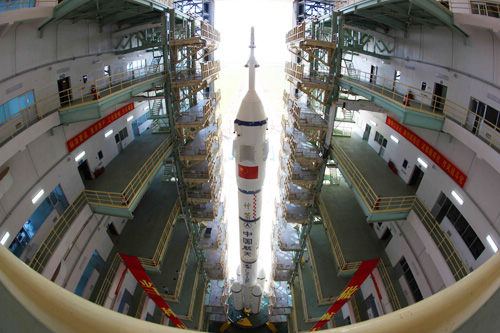|
 |
|
READY TO GO: Shenzhou-9 spacecraft and its carrier rocket are transferred to the launch pad at the Jiuquan Satellite Launch Center in northwest China's Gansu Province on June 9 (WANG JIANMIN) |
High in the sky
Just one day before Jiaolong accomplished its task, the return capsule of the Shenzhou-9 mission landed in north China's Inner Mongolia Autonomous Region at 10:03 a.m. on June 29 as planned.
"The result is satisfactory, the process is perfect, and the mission will bear fruit," said Wang Zhaoyao, Director of the China Manned Space Agency, at a news conference after the Shenzhou-9 spacecraft's landing.
On June 16, Shenzhou-9 blasted off from the Jiuquan Satellite Launch Center in northwest China's Gansu Province, taking Liu Yang, the country's first female astronaut, together with her two male crewmates, into space.
Over 13 days of space flight, the spacecraft conducted two dockings with Tiangong-1 space lab module, one automatic and the other manual.
The three astronauts also completed a string of scientific experiments that will help research on how to better protect astronauts' health in long-duration missions.
Experts say that the success of the manual rendezvous and docking means that China is fully capable of transporting humans and cargo to an orbiter in space, which is essential for the country's plans to build a space station in orbit around 2020.
According to China's three-phase strategy for its manned space program, the second strategic target includes mastering three basic technologies of manned spaceflight and building a temporary space lab that is manned for a short term.
China started its manned space program in 1992. Since then, nine spacecraft and one space lab module have been launched. Including the Shenzhou-9 mission, a total of four flights were manned, and eight astronauts have traveled to space.
Next year, China will launch another spacecraft, Shenzhou-10, to dock with Tiangong-1 for a repeated test of the space docking technology, said Wu Ping, a spokeswoman for the country's manned space program, on June 24.
According to Wang, China has invested 39 billion yuan ($6.14 billion) in the manned space program. The investment has largely been directed toward research and development, sample development and covering the costs of experiments.
"Through previous missions, China has mastered the essential elements of manned spaceflight—the technology to transport human beings between space and the Earth, extravehicular activity technology and space rendezvous and docking technology," Wang said.
The manned space program has earned more than 900 national patents and technological awards, helping to promote research in relevant scientific sectors.
"The aerospace industry and marine industry have become two new driving forces of China's economy," said Lu Wei, Director of the Department of Technology and Economy at the Development Research Center of the State Council.
The aerospace economy covers a wide range of industries, including energy, steel, new materials, electronics, machinery and communications, according to reports. Textile, garment, agricultural and food processing companies are also involved.
The vast range of equipment needed to build and launch Shenzhou spacecraft spurs development in China's basic equipment industries, said Yang Yuguan, a researcher with the China Aerospace Science and Industry Corp.
"Our satellite telecommunications and satellite navigation will also be improved through manned spaceflight systems, which will better be able to service our automobile industries in the future," Yang said.
Wang said the development of space technology is closely related to everyone's daily lives, citing examples from television broadcasting and disaster control.
"Four hundred technologies developed through the space program have been applied in education, mining and health care sectors," Wang said.
According to a survey by the China Aerospace Science and Technology Corp., 80 percent of the more than 1,000 types of new materials developed in China in recent years have benefited from space technology. Moreover, nearly 2,000 kinds of space technology have been adopted in various sectors of the national economy.
Email us at: yinpumin@bjreview.com | 